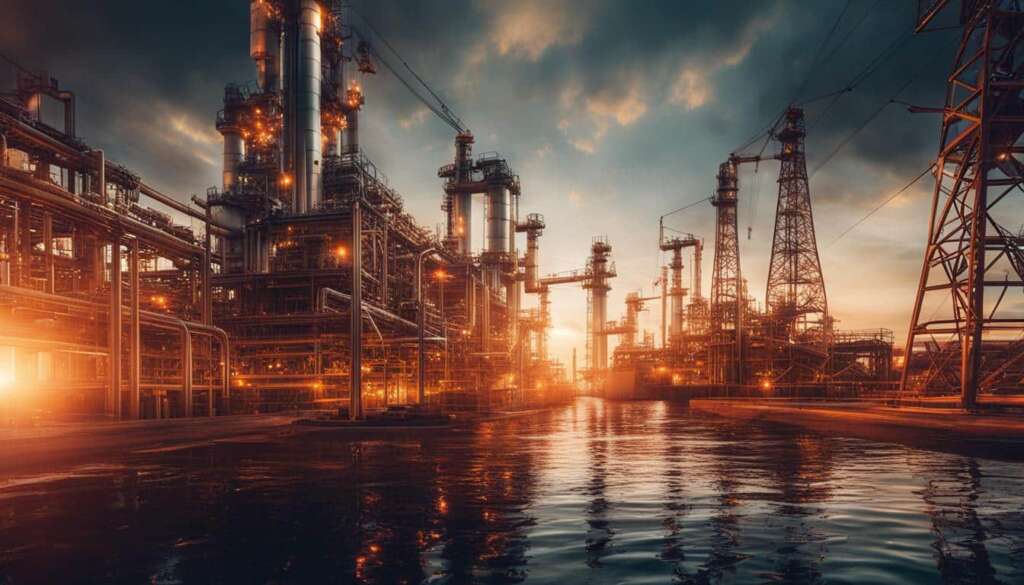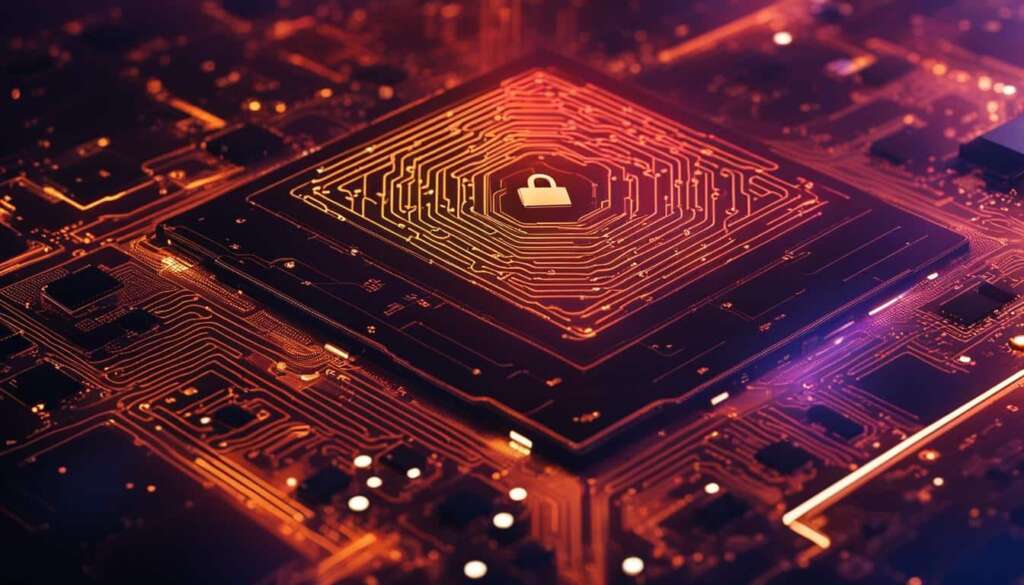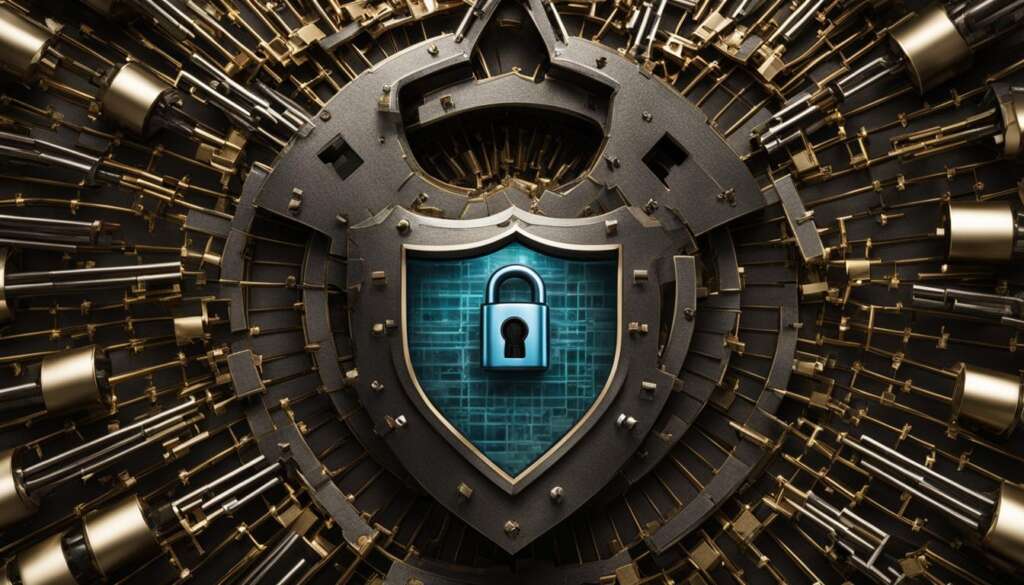Table of Contents
As the energy sector continues to embrace digitalization and interconnected technologies, ensuring robust cybersecurity measures is of paramount importance. The increasing reliance on digital infrastructure exposes the sector to cyber threats that can have devastating consequences. Protecting the energy sector from cyber threats requires a proactive and multi-faceted approach that addresses the unique challenges faced by the industry.
In this article, we will explore the cybersecurity challenges specific to the energy sector and discuss potential solutions to mitigate these risks. From strategic intelligence on threats and actors to reducing gaps in awareness and fostering industry-wide collaboration, we will delve into the key strategies for safeguarding the energy sector against cyber threats.
Join us as we delve into the world of energy sector cybersecurity and discover how protecting critical energy infrastructure is crucial for a secure and resilient future.
The Increasing Cyber Threats in the Energy Sector
The energy sector is facing a growing number of cyber threats that pose significant risks to its operations and infrastructure. These threats come from a range of actors, including nation-states, cybercriminals, and hacktivists. As the sector becomes more digitalized and interconnected, the potential for cyberattacks increases, highlighting the need for enhanced cybersecurity measures.
The risks faced by the energy industry include data theft, billing fraud, and ransomware attacks. Cybercriminals are targeting utilities and other critical infrastructure players for financial gain. The geographic and organizational complexity of energy companies further amplifies their vulnerability, making it challenging to secure funding and establish consistent regulatory frameworks to combat cyber threats.
To address these challenges, the energy sector must prioritize cyber risk management and enhance cybersecurity measures. This involves adopting a multi-layered approach that includes robust threat intelligence, continuous monitoring, and proactive defense mechanisms. By investing in cutting-edge technologies and fostering industry collaboration, the energy sector can better protect itself from cyber threats and safeguard its critical infrastructure.
| Common Cyber Threats in the Energy Sector | Potential Impact |
|---|---|
| Data theft | Compromised customer information, intellectual property theft |
| Billing fraud | Financial losses, reputational damage |
| Ransomware attacks | Disruption of operations, financial extortion |
“Cybersecurity is not just an IT issue; it is a business imperative for the energy sector. It requires a comprehensive and proactive approach to address the evolving landscape of cyber threats,” emphasizes Jane Smith, a cybersecurity expert in the energy industry.
The Vulnerabilities of the Energy Sector
The energy sector faces numerous vulnerabilities that increase the risk and impact of cyber threats. With the increasing quantity of cyber attacks and the growing number of threat actors targeting the sector, the need for robust cybersecurity measures has never been greater. One significant vulnerability lies in the geographic and operational complexity of utilities and their interdependencies between physical and cyber infrastructure. These intricacies create opportunities for exploitation by malicious actors seeking to disrupt critical energy systems.
Another vulnerability stems from the consumer-facing devices utilized in the energy sector. These devices, such as smart meters and control systems, may have security weaknesses that can be exploited. Additionally, regulatory inconsistencies across different regions and countries pose challenges to securing the energy sector from cyber attacks. A harmonized and standardized approach to regulations and cybersecurity protocols would greatly enhance the sector’s overall resilience.
To illustrate the vulnerabilities of the energy sector, the following table provides an overview of specific risks:
As seen in the table, the vulnerabilities range from operational weaknesses in communication systems to the potential for widespread disruption caused by targeted cyber attacks. The table underscores the importance of cybersecurity in the energy sector and highlights the need for comprehensive strategies to address these vulnerabilities.
Strategic Intelligence and Forward-Looking Approach
In order to effectively mitigate cyber risks in the energy sector, a strategic intelligence and forward-looking approach is crucial. It is essential for companies to have a deep understanding of the threats and actors targeting the industry, as well as the potential vulnerabilities that may arise in the future. By staying ahead of emerging threats and attack vectors, energy sector leaders can proactively identify and address potential risks.
Implementing security-minded plans is a key aspect of this forward-looking approach. Security considerations must be integrated into critical decisions about corporate expansion and infrastructure development. By incorporating cybersecurity from the outset of any project or initiative, energy organizations can ensure that security measures are built into the foundation of their operations.
Strategic Intelligence
Strategic intelligence on threats and actors plays a vital role in cybersecurity. By continuously monitoring the threat landscape and gathering intelligence on potential risks, energy sector companies can better understand the tactics and motivations of threat actors. This information enables them to develop robust defense strategies and allocate resources effectively.
Security-Minded Plans
Developing security-minded plans is essential for addressing unknown threats and attack vectors. These plans should encompass a comprehensive approach to cybersecurity, including measures to protect physical and cyber infrastructure, secure consumer-facing devices, and address regulatory inconsistencies. By taking a holistic view of security, energy sector organizations can mitigate risks and safeguard their operations.
| Benefits of Strategic Intelligence and Security-Minded Plans |
|---|
|
By adopting a strategic intelligence and forward-looking approach, energy sector organizations can position themselves to effectively address the evolving cyber risks they face. This proactive stance will enable them to identify and mitigate potential vulnerabilities, protect critical infrastructure, and ensure the security and resilience of the energy sector as a whole.
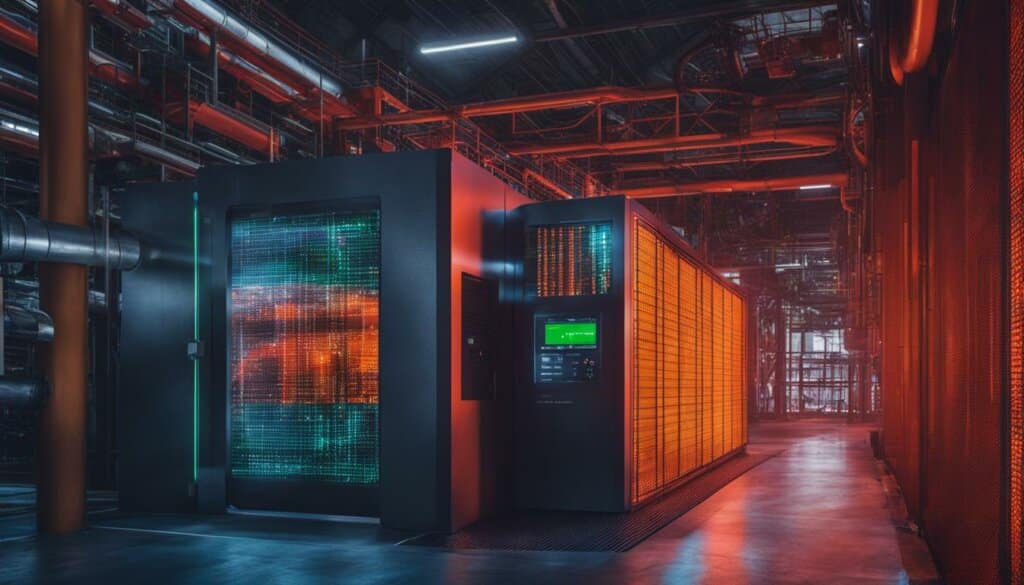
Reducing Gaps in Awareness and Communication
The energy sector faces significant challenges in reducing gaps in awareness and communication when it comes to cybersecurity. These gaps can leave critical infrastructure vulnerable to cyber threats. To create a culture of security in the energy sector, it is crucial to address both geographic and operational gaps that exist within the industry.
One of the key steps in reducing geographic gaps is to ensure that security measures are implemented consistently across all locations. This includes not only centralizing security policies and procedures but also providing adequate training and resources to employees at every level of the organization. By fostering a sense of responsibility and awareness among all stakeholders, it becomes easier to identify and respond to potential cyber threats in a timely manner.
Operational gaps, on the other hand, can be mitigated through the implementation of robust communication systems and technologies. Technical systems that provide a common operating picture can help detect coordinated attacks and reconnaissance campaigns, allowing for swift and coordinated responses. Additionally, establishing partnerships and collaborations within the industry can help bridge the gap between physical and virtual infrastructure, ensuring that all aspects of the energy sector are adequately protected.
The Importance of Collaboration
“Collaboration is key to securing the energy sector,” says cybersecurity expert John Smith. “No single entity can tackle the challenges alone. By working together, organizations can share insights, best practices, and threat intelligence, ultimately strengthening the overall security posture of the industry.”
In conclusion, reducing gaps in awareness and communication is essential for creating a culture of security in the energy sector. By addressing geographic and operational gaps, implementing robust communication systems, and fostering industry collaborations, the sector can be better prepared to defend against cyber threats. With the collective efforts of all stakeholders, the energy sector can enhance its cybersecurity measures and protect critical infrastructure from evolving cyber risks.
Industry-Wide Collaboration for Cybersecurity
The energy sector is facing an increasing convergence of physical and virtual threats, making industry-wide collaboration essential for maintaining cybersecurity. By engaging in regular dialogue and partnerships, stakeholders can work together to secure the delicate ties between physical and virtual infrastructure.
Through collaboration, industry players can share information and best practices, enhancing their ability to detect and respond to emerging threats. By discussing leading-edge technologies and vulnerabilities, they can stay ahead of cybercriminals and adopt proactive security measures.
Industry-wide collaboration also enables the development of joint initiatives and research partnerships. By pooling resources and expertise, stakeholders can drive innovation in cybersecurity and create robust defense mechanisms.
Emerging Risks and Shifts in the Energy Sector
The energy sector is constantly evolving, driven by technological advancements and changes in the geopolitical landscape. As the industry moves towards decarbonization and embraces the Future of Energy, new risks and challenges emerge in the realm of cybersecurity. The increasing interconnectedness of systems and the growing sophistication of threat actors have highlighted the need for enhanced cybersecurity measures.
One of the emerging risks in the energy sector is the rise of evolving cyber threats. Threat actors are continuously adapting their tactics to exploit vulnerabilities in energy infrastructure. The quantity of cyber attacks targeting the industry has seen a significant increase, posing a substantial risk to critical operations. These evolving cyber risks require organizations in the energy sector to adopt a proactive approach to cybersecurity.
As the energy sector becomes increasingly digitized and reliant on interconnected systems, the risk of killware threats has become more prevalent. Killware refers to malicious software designed to cause physical harm, such as shutting down critical infrastructure or causing equipment failure. The potential consequences of such attacks are devastating, emphasizing the urgency to strengthen cybersecurity measures in the energy sector.
| Emerging Risks | Evolving Cyber Risks |
|---|---|
| Increased dependency on digital systems | New tactics and techniques employed by threat actors |
| Rapid technological advancements | Growing sophistication of cyber attacks |
| Decentralization of energy sources | Emergence of killware threats |
Understanding and addressing these emerging risks is crucial to ensure the security and resilience of the energy sector. Organizations must remain vigilant, continuously updating their cybersecurity strategies to adapt to evolving threats. Collaboration between industry stakeholders, government agencies, and research institutions is key to staying ahead of cyber risks and developing effective mitigation strategies.
The Roles in Addressing Security Risks
In order to effectively address security risks in the energy sector, it is essential for various roles and individuals to be actively involved in cybersecurity efforts. While the chief security officer (CSO) plays a crucial role in providing cybersecurity leadership, it is equally important for operational leaders and individuals throughout the organization to be aware of the risks and actively participate in maintaining cybersecurity.
A culture of individual responsibility and security awareness should be fostered within the energy sector to mitigate cyber threats effectively. This includes promoting cybersecurity training and education for all employees, from the executive level to the front-line staff. Encouraging individuals to stay informed about the latest threats and best practices, and empowering them to report any suspicious activity, can significantly enhance the overall security posture of the industry.
Furthermore, collaboration between different roles and departments is essential for a comprehensive and integrated approach to cybersecurity. This includes close coordination between IT personnel, operations teams, and security professionals. By working together, these different roles can ensure that cybersecurity measures are implemented throughout the organization and that any vulnerabilities or weaknesses are addressed in a timely manner. Each role within the energy sector has a vital part to play in protecting critical infrastructure from cyber threats and preserving the stability of the sector.
The Role of the Chief Security Officer
“The chief security officer (CSO) is responsible for setting the strategic direction of cybersecurity within an organization. They play a pivotal role in developing and implementing policies, procedures, and controls to safeguard the energy sector from cyber threats. The CSO works closely with other executive leaders to ensure that cybersecurity is a top priority and that the necessary resources are allocated to address emerging risks. They also collaborate with industry partners, government agencies, and other stakeholders to share threat intelligence and best practices. The CSO serves as the key point of contact for cybersecurity matters and represents the organization in discussions and initiatives related to energy sector cybersecurity.”
The collective effort and individual responsibility of all stakeholders in the energy sector are crucial for maintaining a strong and resilient cybersecurity posture. By recognizing the importance of their role and working collaboratively, these stakeholders can effectively mitigate the evolving cyber risks that threaten the industry.

Strategies for Mitigating Cyber Risks
The energy sector faces significant cyber risks that can have detrimental effects on operations and infrastructure. To effectively mitigate these risks, energy organizations must adopt a multi-layered approach that includes proactive measures, incident response planning, and robust recovery strategies. Here are some key strategies for mitigating cyber risks in the energy sector:
1. Implement a Zero-Trust Security Posture
A zero-trust security posture involves treating every user, device, and network component as potentially untrusted. By implementing strict access controls, continuous monitoring, and verification mechanisms, organizations can reduce the risk of unauthorized access to critical systems. This approach ensures that all entities within the network are constantly validated and authorized, mitigating the potential impact of a cyber attack.
2. Extend Cyber Controls to End Points
Securing end points, such as laptops, mobile devices, and Internet of Things (IoT) devices, is crucial in protecting the energy sector from cyber threats. Organizations should implement robust endpoint security measures, including advanced threat detection, encryption, and regular patch management. By extending cyber controls to all end points, organizations can minimize the risk of breaches and unauthorized access.
3. Develop Resilience Planning and Incident Response
Preparing for cyber incidents is essential in maintaining continuity of operations and minimizing the impact of a breach. Energy organizations should develop comprehensive resilience plans that encompass proactive measures, such as regular backups, system redundancy, and disaster recovery strategies. Additionally, establishing a well-defined incident response plan enables organizations to detect, contain, and recover from cyber attacks effectively.
4. Continually Monitor and Collaborate
Continual monitoring of networks, systems, and user activity is crucial in detecting abnormal behavior and potential security breaches. Energy organizations should invest in advanced security monitoring tools and establish robust collaboration channels between IT teams, operational teams, and external stakeholders. Timely detection and information sharing can greatly enhance the sector’s ability to respond to emerging cyber threats.
By implementing these strategies and adopting a proactive mindset, the energy sector can significantly mitigate cyber risks and safeguard critical infrastructure. Ongoing collaboration, investments in advanced technologies, and regular training and awareness programs are essential in staying ahead of evolving cyber threats.
Partnerships for Addressing Emerging Threats
Partnerships and collaborations play a crucial role in addressing the emerging threats in the energy sector. The complexity of cyber threats requires a collective effort from both public and private entities to effectively mitigate risks and enhance cybersecurity. Through public-private collaboration, valuable insights, resources, and expertise can be shared to develop robust defense mechanisms and stay ahead of evolving threats.
Industry-wide partnerships foster information sharing and coordination among stakeholders, allowing for a more comprehensive understanding of cybersecurity challenges and best practices. Collaborations with federal agencies, industry organizations, and research partnerships contribute to the development of innovative solutions and strategies.

Public-Private Collaboration in the Energy Sector
Public-private collaboration in the energy sector helps bridge the gap between government agencies and industry players. By working together, they can identify potential vulnerabilities, share threat intelligence, and develop effective response plans. This collaboration also enables the alignment of regulatory frameworks and standards, ensuring a more cohesive and coordinated approach to cybersecurity in the sector.
“Public-private collaboration in the energy sector helps bridge the gap between government agencies and industry players.”
Effective public-private collaboration requires open lines of communication, trust, and a shared commitment to safeguarding critical infrastructure. Regular dialogues, workshops, and forums provide opportunities for knowledge exchange, capacity building, and the development of joint initiatives. Through these partnerships, the energy sector can strengthen its resilience against emerging threats and ensure the security of its infrastructure.
Table: Examples of Public-Private Partnerships in the Energy Sector
| Partnership | Description |
|---|---|
| National Council of Information Sharing and Analysis Centers (ISACs) | A platform for industry-specific sharing of threat intelligence and best practices. |
| Critical Infrastructure Partnership Advisory Council (CIPAC) | An advisory council that encourages public and private sector collaboration on critical infrastructure security and resilience. |
| Energy Sector Coordinating Council (ESCC) | A forum for coordinating and implementing strategies to enhance the security and resilience of the energy sector. |
DOE’s Efforts in Cybersecurity
The Department of Energy (DOE) is at the forefront of ensuring the security and resilience of critical energy infrastructure. As the Sector-Specific Agency for electrical infrastructure, the DOE plays a crucial role in coordinating activities to strengthen the security of the electricity subsector.
DOE recognizes the importance of collaboration and partnerships in enhancing cybersecurity in the energy sector. By engaging with industry partners, federal agencies, and stakeholders, DOE promotes information sharing and best practices to combat cyber threats effectively. Regular dialogue and collaboration among industry stakeholders are necessary to secure the delicate ties between physical and virtual infrastructure.
Being proactive is key to addressing the evolving cyber landscape. That’s why DOE supports research, development, and demonstration of advanced cybersecurity solutions to stay ahead of emerging threats. By investing in cutting-edge technologies and fostering innovation, DOE aims to enhance the overall security posture of the energy sector.
DOE’s initiatives also extend to fostering a culture of cybersecurity. By promoting individual responsibility and security awareness, DOE empowers individuals throughout the energy sector to actively participate in maintaining cybersecurity. This collective effort helps mitigate cyber risks and strengthens the industry’s overall resilience.
| DOE’s Cybersecurity Initiatives | Key Benefits |
|---|---|
| Coordination with industry partners, federal agencies, and stakeholders | Enhanced information sharing and collaboration |
| Support for research, development, and demonstration of advanced cybersecurity solutions | Stay ahead of emerging threats and promote innovation |
| Promotion of individual responsibility and security awareness | Empower individuals to actively participate in maintaining cybersecurity |
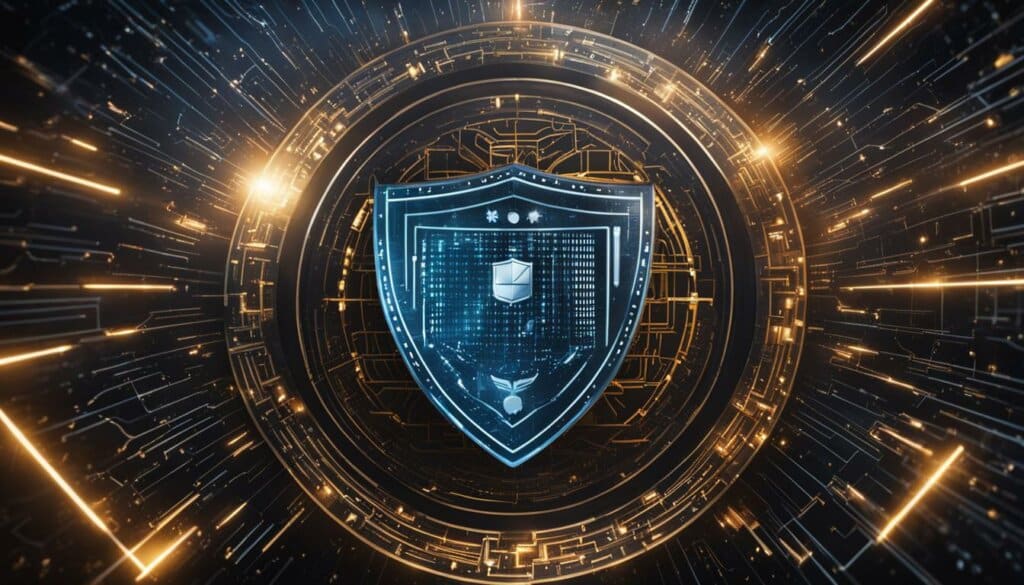
Conclusion
In conclusion, securing the energy sector from cyber threats requires a proactive and comprehensive approach to cybersecurity. It is crucial to have strategic intelligence on threats and actors, as well as to reduce gaps in awareness and communication. Industry-wide collaboration plays a significant role in addressing the evolving risks in the energy sector.
The vulnerabilities of the energy sector, including its expansive attack surface and interdependencies between physical and cyber infrastructure, make it susceptible to exploitation. To enhance cybersecurity, it is necessary to address emerging threats and build a culture of security throughout the industry.
Partnerships and collaborations, both within the sector and with government agencies, are vital in sharing threat intelligence and best practices. The efforts of organizations like the Department of Energy (DOE) in promoting cybersecurity initiatives and supporting research and development are commendable.
Ultimately, securing the energy sector against cyber threats requires the collective responsibility of all stakeholders. By implementing strategic measures and fostering a culture of security, the industry can mitigate risks and ensure the resilience of critical energy infrastructure.
FAQ
What are the main cybersecurity challenges faced by the energy sector?
The energy sector is increasingly vulnerable to cyber threats from various actors, including nation-states, cybercriminals, and hacktivists. The sector’s expansive attack surface and interdependencies between physical and cyber infrastructure make it susceptible to exploitation.
Who are the main threat actors targeting the energy sector?
The energy sector faces threats from nation-states, cybercriminals, and hacktivists. These threats include data theft, billing fraud, and ransomware attacks. Utilities and other critical infrastructure players are targeted for profit, and their geographic and organizational complexity makes them vulnerable.
What are the vulnerabilities of the energy sector?
The energy sector’s vulnerabilities arise from its geographic and operational complexity, along with the interdependencies between physical and cyber infrastructure. Inconsistent securing funding and regulatory inconsistencies further contribute to the vulnerabilities of the industry.
How can strategic intelligence and a forward-looking approach help address cybersecurity challenges?
Strategic intelligence on threats and actors is crucial for energy companies to integrate security into critical decisions about corporate expansion and infrastructure. Having security-minded plans to address unknown threats and attack vectors is essential, as well as being proactive in identifying and addressing potential vulnerabilities.
How can gaps in awareness and communication be reduced in the energy sector?
To create a culture of security, it is important to ensure that the best minds across the enterprise are aware of threats and have robust reporting processes. Technical systems should provide a common operating picture to detect coordinated attacks and reconnaissance campaigns.
Why is industry-wide collaboration important in securing the energy sector?
Industry collaboration and partnerships are crucial in securing the ties between physical and virtual infrastructure. Regular dialogue and collaboration among industry stakeholders help to share threat intelligence and mitigation strategies, staying ahead of emerging threats in the energy sector.
What are the emerging risks and shifts in the energy sector?
The energy sector faces new risks in the rapidly changing technology and geopolitical landscape. The quantity of cyber attacks has increased, and threats actors are evolving their tactics. Killware threats, which can cause physical harm, are becoming more prevalent.
What roles are involved in addressing security risks in the energy sector?
While the chief security officer plays a crucial role in cybersecurity leadership, operational leaders and individuals throughout the organization need to be aware of the risks and actively participate in maintaining cybersecurity. A culture of individual responsibility and security awareness is necessary to mitigate cyber threats effectively.
What are the strategies for mitigating cyber risks in the energy sector?
Energy organizations can mitigate cyber risks by identifying and detecting threats specific to their sector, continual monitoring, and internal collaboration. Adopting a zero-trust security posture, extending cyber controls to endpoints, and resilience planning are also important strategies for enhancing cybersecurity.
How can partnerships address emerging threats in the energy sector?
Partnerships and alliances are key in addressing emerging threats. Public-private relationships play a crucial role in sharing threat intelligence and mitigation strategies. Collaborations with federal agencies, industry organizations, and research partnerships can help enhance cybersecurity in the sector.
What is the role of the Department of Energy (DOE) in cybersecurity?
The DOE plays a crucial role in ensuring the security and resilience of critical energy infrastructure. As the Sector-Specific Agency for electrical infrastructure, DOE coordinates activities to strengthen the security of the electricity subsector. DOE supports research, development, and demonstration of advanced cybersecurity solutions and promotes information sharing and best practices.
How can the energy sector enhance its cybersecurity efforts?
A proactive and comprehensive approach to cybersecurity is necessary in the energy sector. Strategic intelligence, reducing gaps in awareness, industry-wide collaboration, and partnerships are key components of mitigating risks. Ongoing efforts by organizations like DOE and the collective responsibility of all stakeholders are essential for securing the energy sector against cyber threats.
Source Links
- https://www2.deloitte.com/us/en/pages/consulting/articles/cybersecurity-energy-sector.html
- https://www.mckinsey.com/capabilities/risk-and-resilience/our-insights/the-energy-sector-threat-how-to-address-cybersecurity-vulnerabilities
- https://www.energy.gov/ceser/cybersecurity

